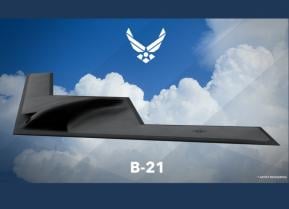China and Russia vs. the B-21 Bomber and F-35 Fighter: Who Wins?
The U.S. military believes an aggressive and accelerated effort will be needed to ensure the U.S. Air Force can succeed against enemy Surface to Air Missiles--like those from Russia and China.
Pacific Air Force Commander Gen. Kenneth Wilsbach believes an aggressive and accelerated multi-faceted effort will be needed to ensure the U.S. Air Force can succeed against enemy Surface to Air Missiles.
Speaking to reporters at the 2021 Air Force Association Symposium Wilsbach made a point to emphasize a two-fold approach, meaning that defeating a new generation of SAMS presents a pressing need to sustain and upgrade current air-superiority capabilities such as the B-2, F-35 and F-22 while also accelerating a new generation of systems such as a 6th-Gen fighter and of course B-21.
“We need to get into those anti-access/area-denial zones and operate in those areas so we can create effects and take down SAMS that are on the land or at sea .. and take away our adversaries' domain awareness,” Wilsbach said.
This is significant in several respects, given ongoing upgrades to the B-2 and F-35. For example, in part for the specific purpose of eluding and defeating Chinese and Russian air defenses, the Air Force is now adding new Defensive Management System sensors to its existing fleet of B-2s. The concept is to ensure that the stealthy aircraft, engineered to elude both surveillance and engagement or targeting radar systems, has an increased ability to identify the location of advanced air defenses and simply seek to avoid them.
The B-2 is also getting new computer processors that are 1,000-fold faster as well as upgraded weapons, as part of a clear effort to mitigate increased risk of detection presented by new air defenses. Longer-range, more precise sensors, coupled with advanced weapons, could perhaps be better positioned to attack and destroy enemy SAMS from better stand-off ranges should their locations be identified. Certainly enemy SAMS present structures detectable to EO-IR cameras and may emit a detectable RF frequency or heat signature identifiable by sensors.
The F-35 is also being massively upgraded with a clear mind to sustaining a decided measure of air-superiority in a more advanced threat environment. Of course, new applications of AI-empowered advanced algorithms likely being built into the jet are continuously able to process, identify and analyze threat information more quickly and accurately, but the platform is also slated to get new weapons in the next several years as well. Many of these weapons not only likely include new multi-frequency and frequency-hopping EW weapons but also greatly improve range and targeting precision. The Stormbreaker air-dropped bomb, for instance, operates with a target-tracking two-way data link, tri-mode all-weather seeker, and an attack range as far as 40-nautical miles; the weapons are now being integrated and tested on the F-35 and is slated to deploy in just the next few years. It takes virtually no imagination to recognize this as the kind of weapon likely to be more successful against sophisticated air defenses.
While both the F-35 and the B-2 are slated to fly for decades into the future, in part due to the series of anticipated ongoing software and weapons upgrades, this does not preclude the Air Force’s vigorous push for fast-emerging new platforms such as the now-underway B-21 and already airborne 6th-Gen fighter. The B-2’s future may not be quite as long as the F-35s, given that there are far-fewer B-2s and that the F-35 is slated to fly well into the 2070s, yet its upgrades are expected to propel the aircraft into future war in coming years as larger numbers of the B-21 arrive.
While virtually nothing is known about B-21 technology for security reasons, it is reported to incorporate a new generation of stealth technologies, computing, and sensor systems designed to defeat the most advanced current and expected air defenses for many years into the future.
Kris Osborn is the defense editor for the National Interest. Osborn previously served at the Pentagon as a Highly Qualified Expert with the Office of the Assistant Secretary of the Army—Acquisition, Logistics & Technology. Osborn has also worked as an anchor and on-air military specialist at national TV networks. He has appeared as a guest military expert on Fox News, MSNBC, The Military Channel, and The History Channel. He also has a Masters Degree in Comparative Literature from Columbia University.


